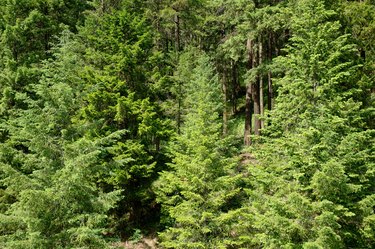
Both narrow- and broadleaf evergreens are vulnerable to insect attack, sometimes just to an unsightly degree, and sometimes to the point of fatality. Since some insect pests respond only to very specific treatment, it is critical to know what you are protecting your shrubs and trees against. Equally important is knowing how much more damage a specific pest can do to your garden as a whole.
Bagworms
Video of the Day
Bagworms appear as spindled bundles of egg sacs on trees and shrubs in spring. Caterpillars emerge from the sacs in May and June and feed on a wide range of evergreens and deciduous plants. Most frequently its targets are arborvitae, followed by red cedar and other members of the juniper family. They will also feed on fir, spruce, pine and hemlock foliage, along with more than 100 trees and shrub varieties. Caterpillars pupate and become moths by September. New egg sacs may winter over and the cycle repeats.
Video of the Day
Damage to an individual plant may be cosmetic or completely defoliating. Death often occurs when a plant is weakened by repeated attacks. Bacilllus thuringiensis is the most frequently-used biological control. Egg sacs can be pruned and should be destroyed away from trees and compost piles to prevent the spread of eggs. The Cornell University Extension Service warns never to use pheremone traps; presumably, they attract more bagworms than they kill.
Borers
The range of damage caused by boring insects is often directly related to the health and vitality of the tree. Those stressed by inadequate water or storm damage may suffer enough damage from borers to die. Depending on the variety of borer, holes can number in the hundreds and reach diameters up to 3/8 inch. Borers may reinvade trees to eat, lay eggs and nurture caterpillars, causing additional damage at each phase of the life cycle.
Pine borers, striped pine borers, bark beetles, Zimmerman pine beetles, mountain pine borers and pine sawyer beetles all tunnel through bark, causing trees to drip heavy amounts of sap and sawdust. Where damage is severe, arborists advise removing dead or dying trees and recommend insecticides that will be digested as borers travel through the bark rather than systemic pest controls that cover the ground.
Sucking Insects
Lacebugs prey upon both conifers and broad-leaved evergreens, sucking out enough sap to produce leaf drop. Tiny and inhabiting the undersides of leaves, lacebugs are hard to detect until damage is done. Different varieties of lacebug attack rhododendron, andromeda, mountain laurel and azalea. Chemical insecticides can be applied most effectively in late May or early June when nymphs are young. Planting broadleafs in full sun exposure can make them more vulnerable to lacebug infestation.
Spider Mites
Also known for destructive sucking, mites are more closely related to spiders than insects. The names mite and spider-mite are used interchangeably. Cool-season mites feed on both conifers and broadleaved evergreens; azalea mites, spruce mites and Southern red mites all belong to the cool-season category. In spite of its host-specific name, the spruce mite attacks more than 40 varieties of evergreen and is the bane of the Christmas tree industry. According to Cornell University Suffolk County Extension, it is the most destructive spider mite in Canada and the U.S.
Warm-season mites like two-spot mites and maple or oak mites favor deciduous plants but some specific-host mites, like oak mites, are exclusive. Cool-season mite activity diminishes as temperatures reach mid-70s degrees Fahrenheit and above, while warm-season activity increases. In some cool-summer areas, like regions of North Carolina, temperatures never rise enough to stem cool-weather mite activity. Beneficial predators like lady beetles or thrips often seem to be more effective in mite control than chemical deterrents.
Scale Insects
Scale insects are sucking insects that leave waxy or cottony deposits on the stems and needles of evergreens. Scale disease varieties number in the thousands, and many are host-specific. Azalea bark scale attacks both azalea and rhododendron. Elongate hemlock scale, on the other hand, threatens 14 species of U.S. native conifers, with spruce and fir even more vulnerable to its devastation than hemlock.
Hemlock damage through the northeastern United States has been substantial, often made worse by the activity of hemlock-specific wooly adelgids. Together, the two infestations strip hemlocks of needles, causing death in single trees, groves and hedges. Drenching with horticultural oils may save individual specimens, but there is at present no good control strategy for large plantings or forests.
- Cornell University Extension of Suffolk County: Insect Problems on Narrow-Leaf Evergreens
- LAM Tree Service: Signs and Symptoms of Mountain Pine Beetle Attack
- Bayer Advanced: How to Prevent Common Tree Pests This Spring
- Purdue Extension Department of Entymology: Borers of Pines and Other Needle Bearing Evergreens in Landscapes
- Clemson University Extension: Azalea and Rhododendron Insect Pests
- Penn State Entomology: Lace Bugs on Broad-Leaved Evergreen Ornamental Plants
- Missouri Botanical Garden: Bagworms
- Rutgers University Extension: Cool Season Mites Fade, As Warm Season Mites Surge
- Ohio State University: Christmas Tree Fact Sheet: Spruce Spider Mite
- United States Department of Agriculture Forest Service Pest Alert: Elongate Hemlock Scale
- University of California at Davis: Integrated Pest Management: Scales